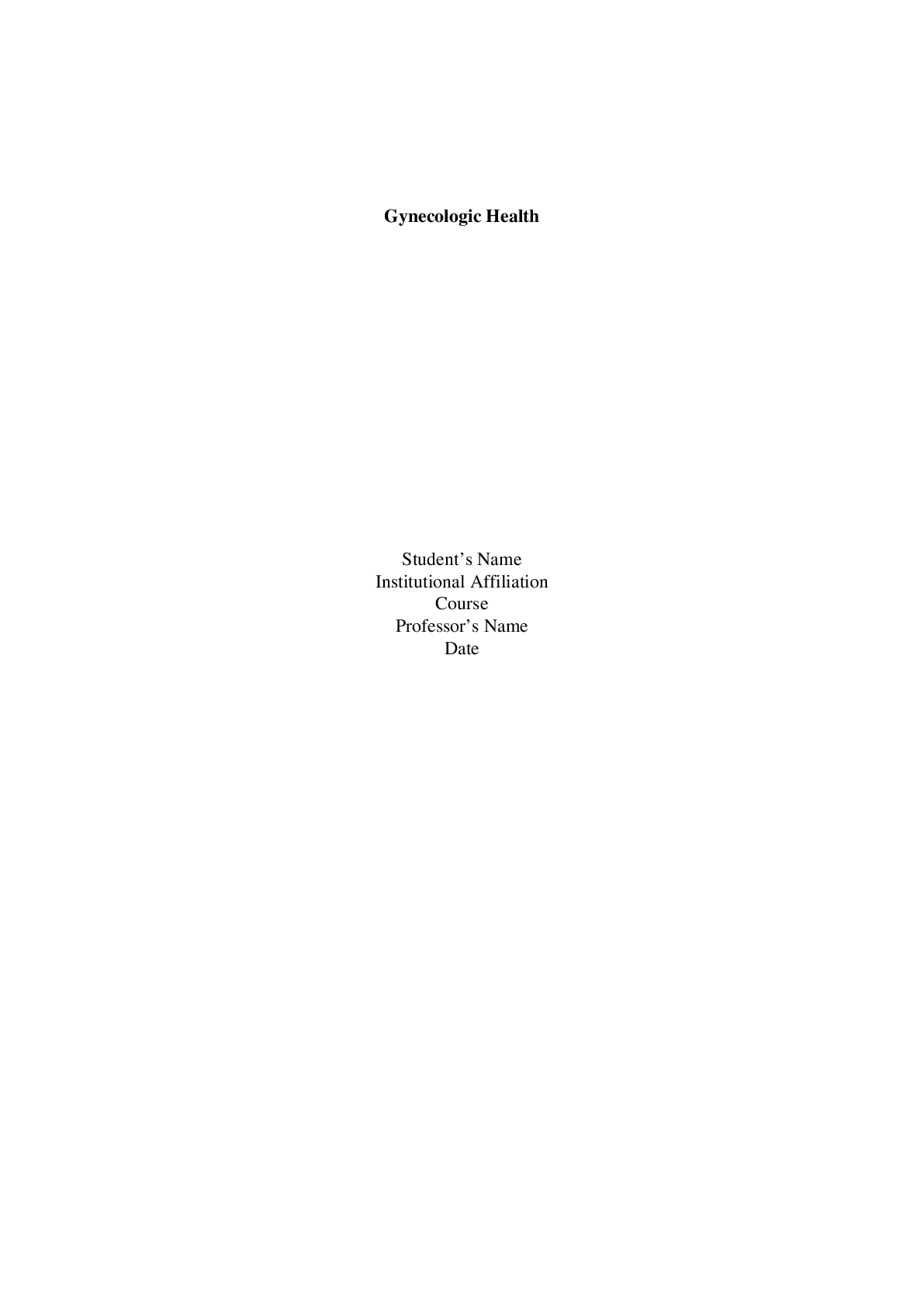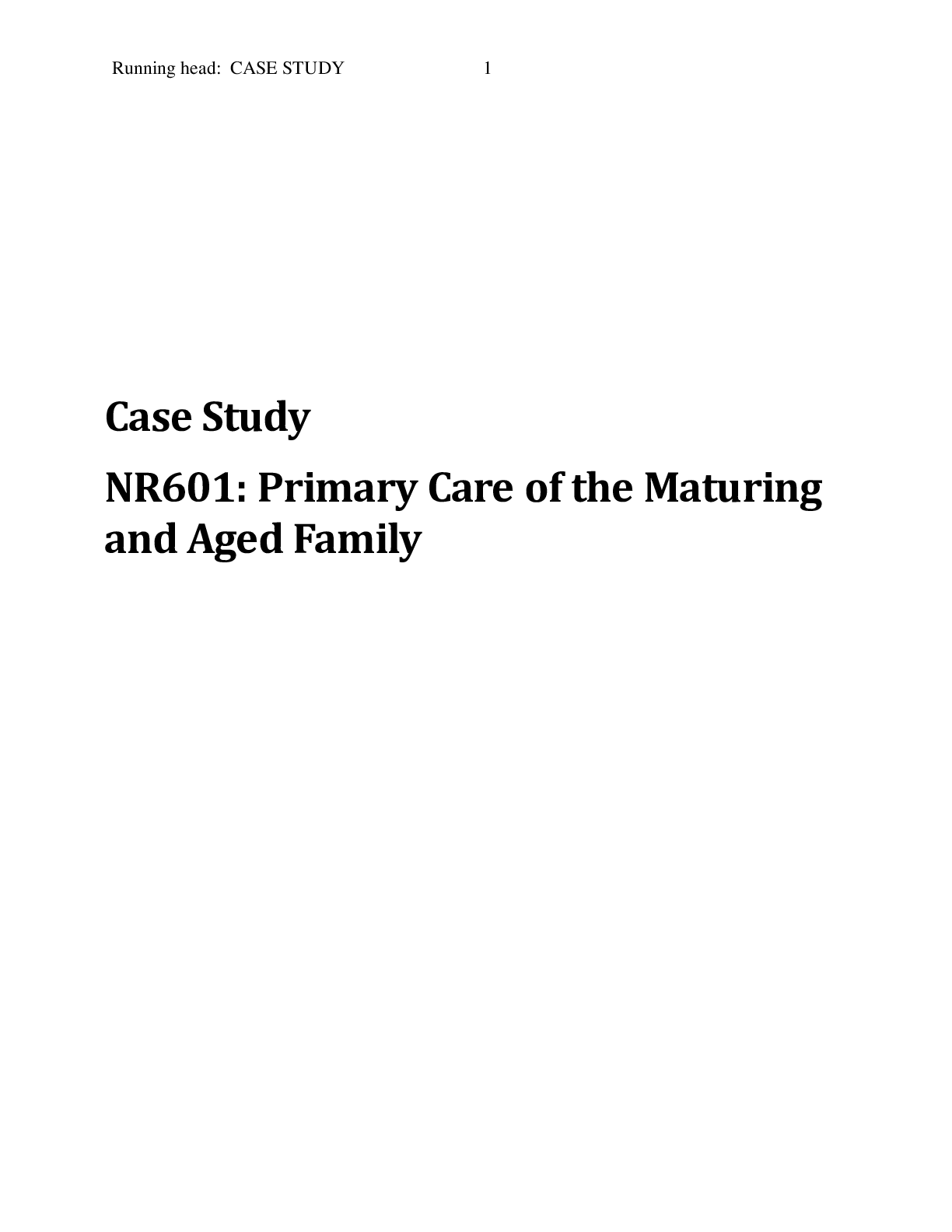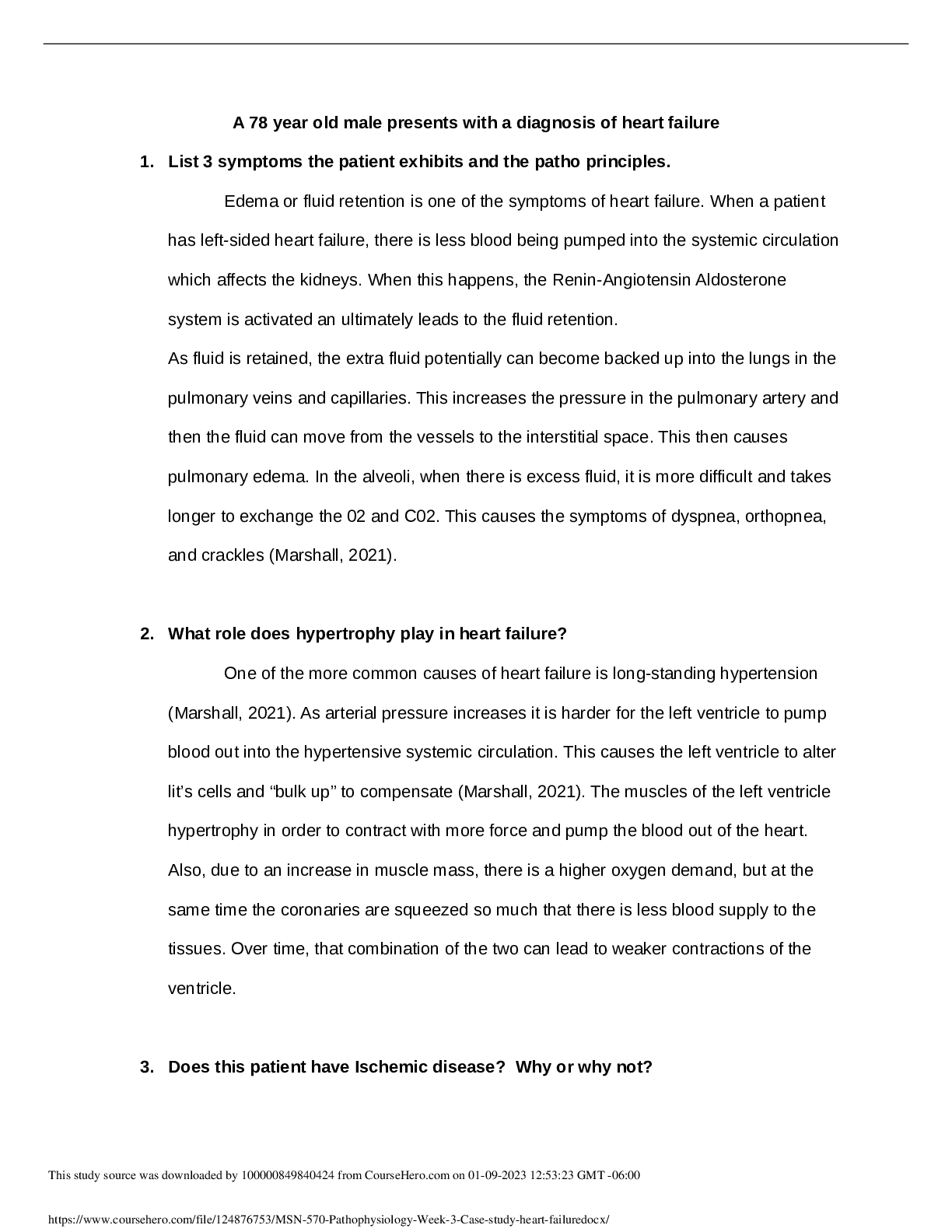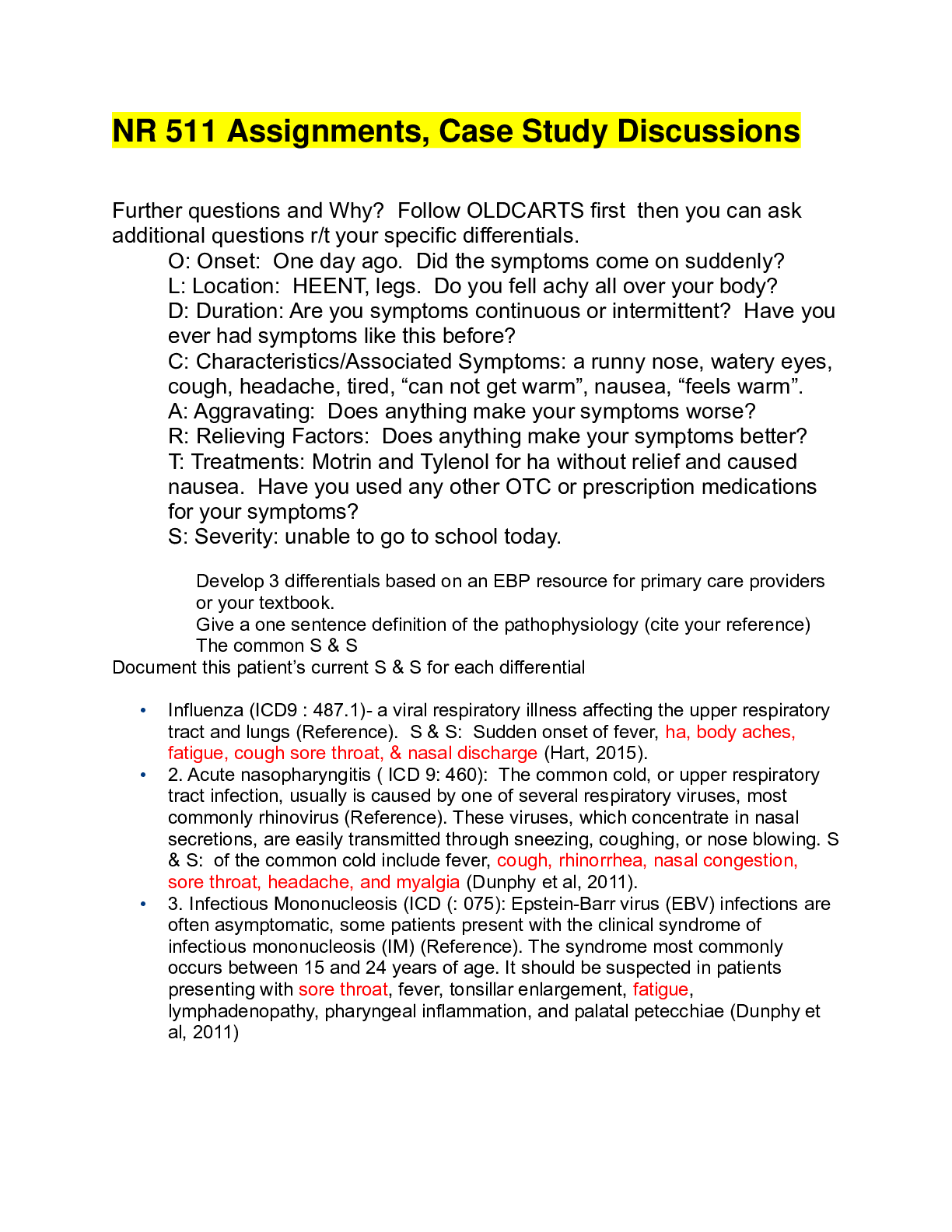*NURSING > CASE STUDY > NR 511 Week 3 Case Study Discussion Part 2 With Answers-Chamberlain College Of Nursing (All)
NR 511 Week 3 Case Study Discussion Part 2 With Answers-Chamberlain College Of Nursing
Document Content and Description Below
1. What is your primary (one) diagnosis for this patient at this time? (support the decision for your diagnosis with pertinent positives and negatives from the case) -Allergic conjunctivitis is the ... most likely diagnosis due to PMH of allergies, relocation to a different climate without current treatment for allergies and assessment findings being negative for purulent drainage, foreign body, fever, or sick contacts. 2. Identify the corresponding ICD-10 code. H10.13- Acute atopic conjunctivitis, both eyes 3. Provide a treatment plan for this patient's primary diagnosis which includes: Medication: -Restart loratadine 10mg daily and fluticasone nasal spray daily for treatment of seasonal allergies. Loratadine 10mg Disp: #30 Sig: Take one tablet by mouth daily RF: 6 (Loratadine, 2016) Fluticasone 50mcg/actuation Disp: 1 nasal spray Sig: 2 sprays per nostril once a day RF: 6 (Fluticasone, 2016) -Add Olopatadine ophthalmic 0.2% solution- 1 drop in each eye once a day. - Olopatadine ophthalmic is the gold standard dual action topical antihistamine treatment for allergic conjunctivitis. It works by superiorly blocking H1 receptors as well as stabilizing mast cells. 0.7% is the newest dosing and is found to be superior to the original 0.1% or 0.2% as it is a daily dosing that gives itch relief for 24 hours versus 18 hours. (Ackerman, Smith, & Gomes, 2014). Pazeo currently does not have a generic compound and therefore is very pricey. Given our particular patient, it would be preferred to start with the 0.2% and considering increasing to 0.7% if the 0.2% is not effective. Olopatadine Ophthalmic 0.2% solution Disp: 2.5 ml eye dropper Sig: Place 1 drop in each eye once a day RF: 0 (Olopatadine Ophthalmic, 2016) -Goal of therapy is to continue therapy until symptoms improve to discover new seasonal allergy time frame due to new allergens in a new location. Patient should see relief of allergic conjunctivitis in 2-3 days. Any additional testing necessary for this particular diagnosis: -Routine cultures and allergen screening are not indicated for allergic conjunctivitis. If symptoms are not managed with current treatment plan, referral to an allergist for allergy skin testing and/or tear immunoglobin E testing can be made (AAO, 2019). Patient education: - Good hand hygiene before contact with the eye or instillation of eye ointment is imperative to prevent further contamination of the eyes with allergens from your hands and to prevent contamination with viruses or bacteria (Hollier, 2018, p. 470). - Cool compresses can help with symptoms and swelling of the eyes (Hollier, 2018, p.470). - Allergen reducing pillowcases and filters in dorm room can help reduce allergens. Referral: - Referral to an Allergen will be discussed if treatment is not effective. 4. Provide an active problem list for this patient based on the information given in the case. 1. H10.13- Acute Allergic Conjunctivitis, bilateral 2. H53.149- acute visual discomfort 3. H11.433- conjunctival hyperemia, bilateral 2. J30.2- Seasonal Allergic Rhinitis 5. Are there any changes that you would also make to this patient’s overall treatment plan at this time? Must provide an EBM argument for each treatment or testing decision. - Given that all testing preformed was normal, I would not change my treatment plan. The diagnosis of allergic conjunctivitis can be made strictly on subjective and objective data therefore testing was not necessary in the first place. According to the American Academy of Ophthalmology (AAO) (2019), the current recommendation is that cultures are only necessary in suspected neonatal conjunctivitis, viral cultures are not routinely recommended but can help in misdiagnosis and unnecessary antibiotic use, and allergy skin testing and/or tear immunoglobin E testing can be performed if necessary for recurrent allergic conjunctivitis that is not responding to therapy (p. P120-P121). At this time, I do not feel a referral for allergy testing is necessary until I have attempted treatment with 0.2% olopatadine ophthalmic solution without success and no success with an increase to 0.7% solution. Olopatadine ophthalmic is the gold standard dual action topical antihistamine treatment for allergic conjunctivitis therefore that will still be my first choice for treatment at this time (Ackerman et al., 2014). 6. Provide an appropriate F/U plan. - Nurse correspondence in 3 days to assess effectiveness of olopatadine solution. -If treatment is effective- follow up in 1 month for reevaluation of allergy symptoms and continuation of treatment if necessary. -If treatment is not effective- follow up in 1 week to discuss increase to 0.7% solution and reassess symptoms. -If symptoms are not controlled after two months of consistent treatment and monitoringreferral to allergist will be considered. Hillary Watkins Ackerman, S., Smith, L. M., & Gomes, P. J. (2016). Ocular itch associated with allergic conjunctivitis: latest evidence and clinical management. Therapeutic advances in chronic disease, 7(1), 52–67. doi:10.1177/2040622315612745 American Academy of Ophthalmology. (2019). Conjunctivitis Preferred Practice Pattern®. Ophthalmology, 126(1). doi:10.1016/j.ophtha.2018.10.020 Fluticasone. (2016). In Epocrates Essentials for Apple iOS (Version 19.1.2) [Mobile application software]. Retrieved from http://www.epocrates.com/mobile/iphone/essential Hollier, A. (2018). Clinical guidelines in primary care (3rd ed.). Lafayette, LA: Advanced Practice Education Associates. Loratadine. (2016). In Epocrates Essentials for Apple iOS (Version 19.1.2) [Mobile application software]. Retrieved from http://www.epocrates.com/mobile/iphone/essential Olopatadine Ophthalmic. (2016). In Epocrates Essentials for Apple iOS (Version 19.1.2) [Mobile application software]. Retrieved from http://www.epocrates.com/mobile/iphone/essential Collapse Subdiscussion Sharon Feehan Sharon Feehan Jul 24, 2019Jul 24 at 11:56pm Manage Discussion Entry Good job, Hillary! I agree with your approach and treatment plan for this patient. Hillary Watkins Hillary Watkins Jul 25, 2019Jul 25 at 2pm Manage Discussion Entry Thank you for your feedback Dr. Feehan. o Collapse Subdiscussion Ancy Pappan Ancy Pappan Jul 24, 2019Jul 24 at 3:53pm Manage Discussion Entry Hello Dr.Feehan and Fellow Classmates, From the given scenario Allergic conjuctivitis can be considered as the primary diagnosis. Pertinent positives: Bilateral redness, tearing, itching, grittiness, history of seasonal allergic rhinitis, mild photophobia,use of marijuana,nasal turbinates pale and boggy. Pertinent negative: No fevver and normal [Show More]
Last updated: 1 year ago
Preview 1 out of 12 pages
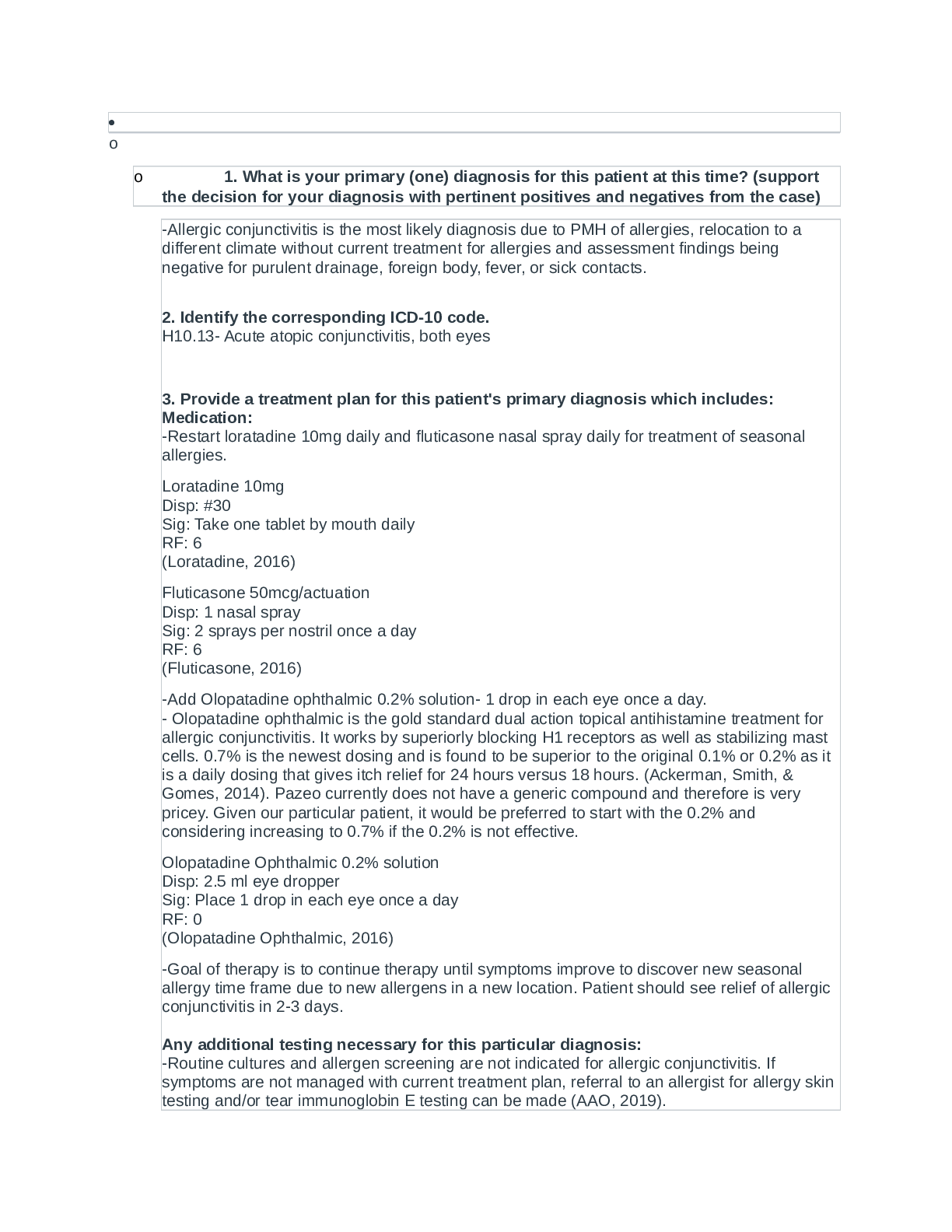
Reviews( 0 )
Document information
Connected school, study & course
About the document
Uploaded On
May 03, 2022
Number of pages
12
Written in
Additional information
This document has been written for:
Uploaded
May 03, 2022
Downloads
0
Views
77
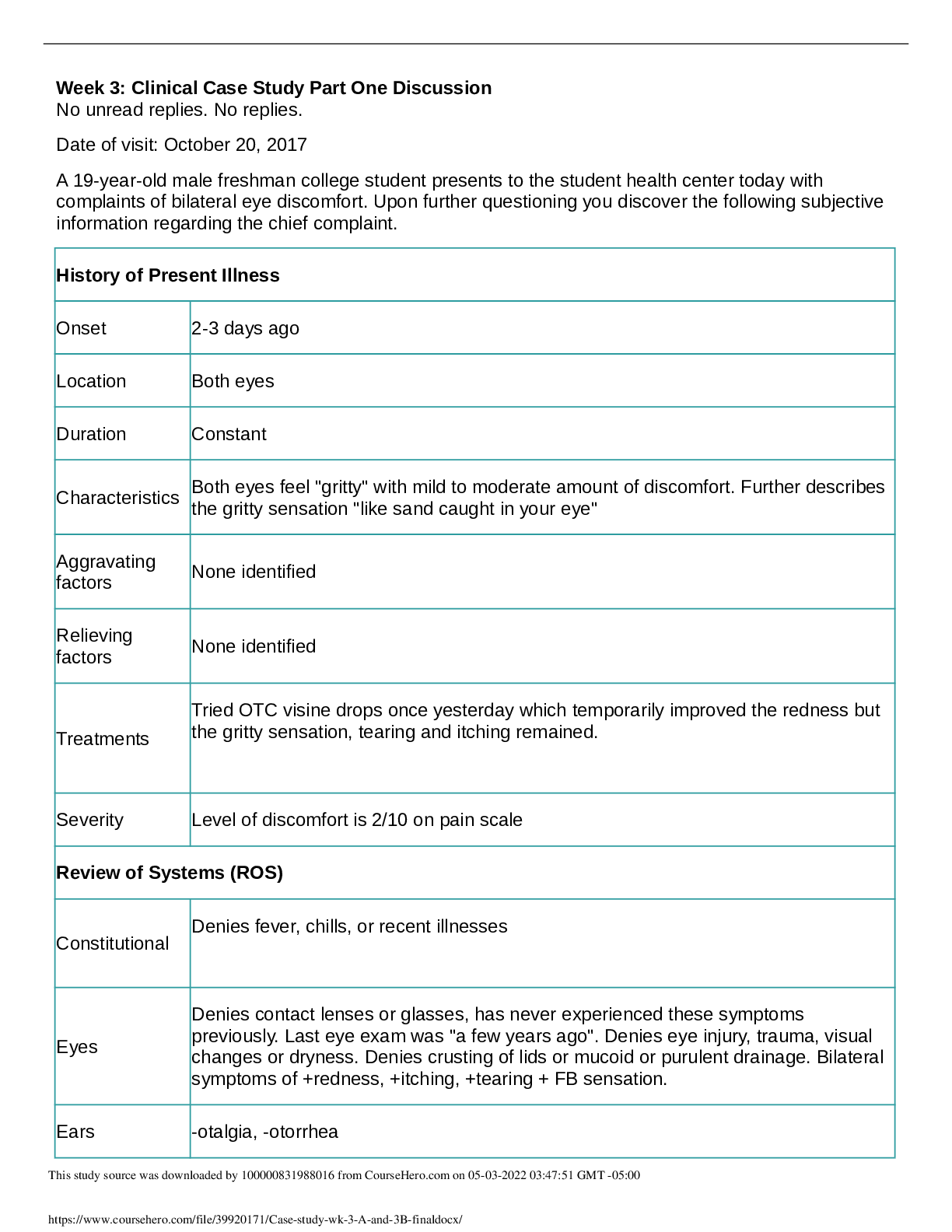

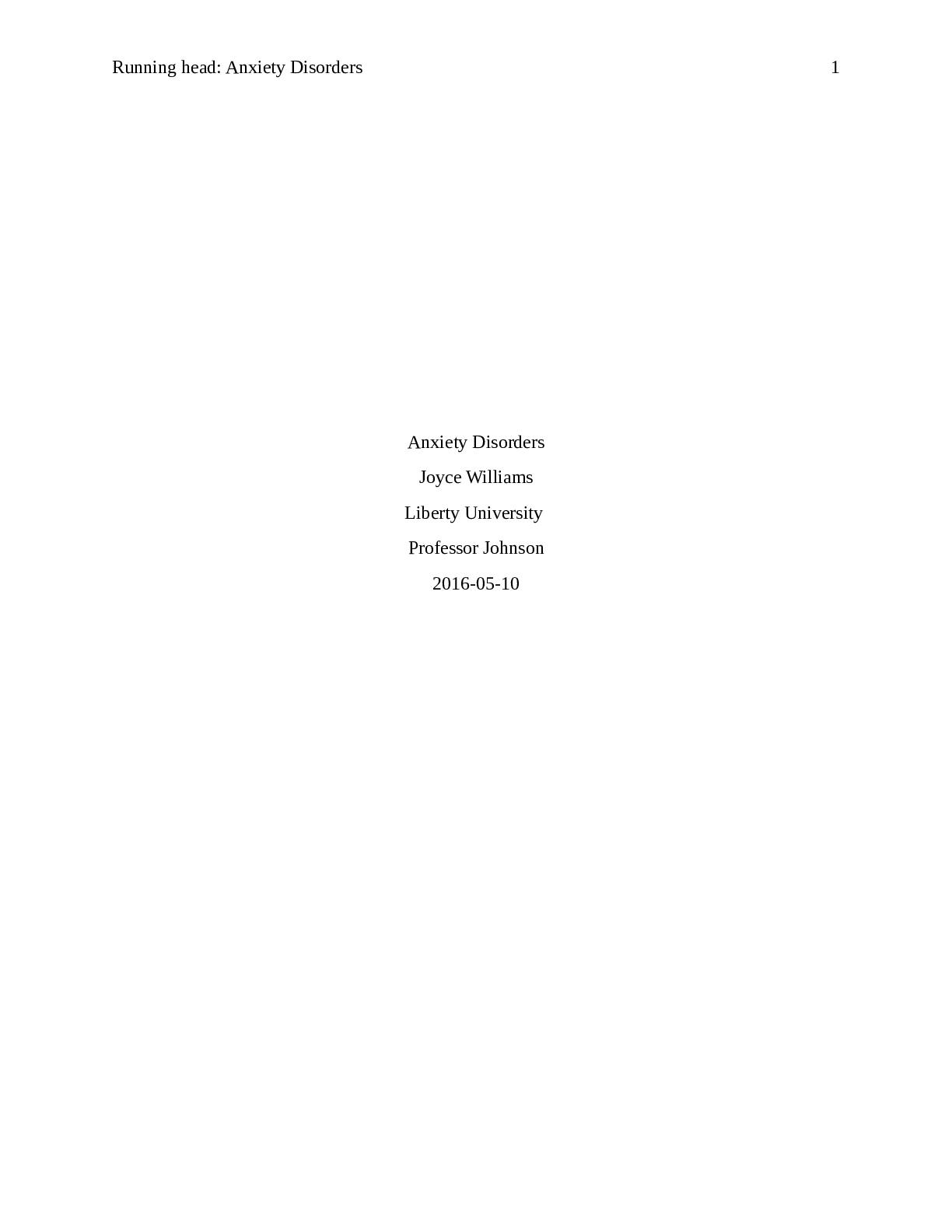
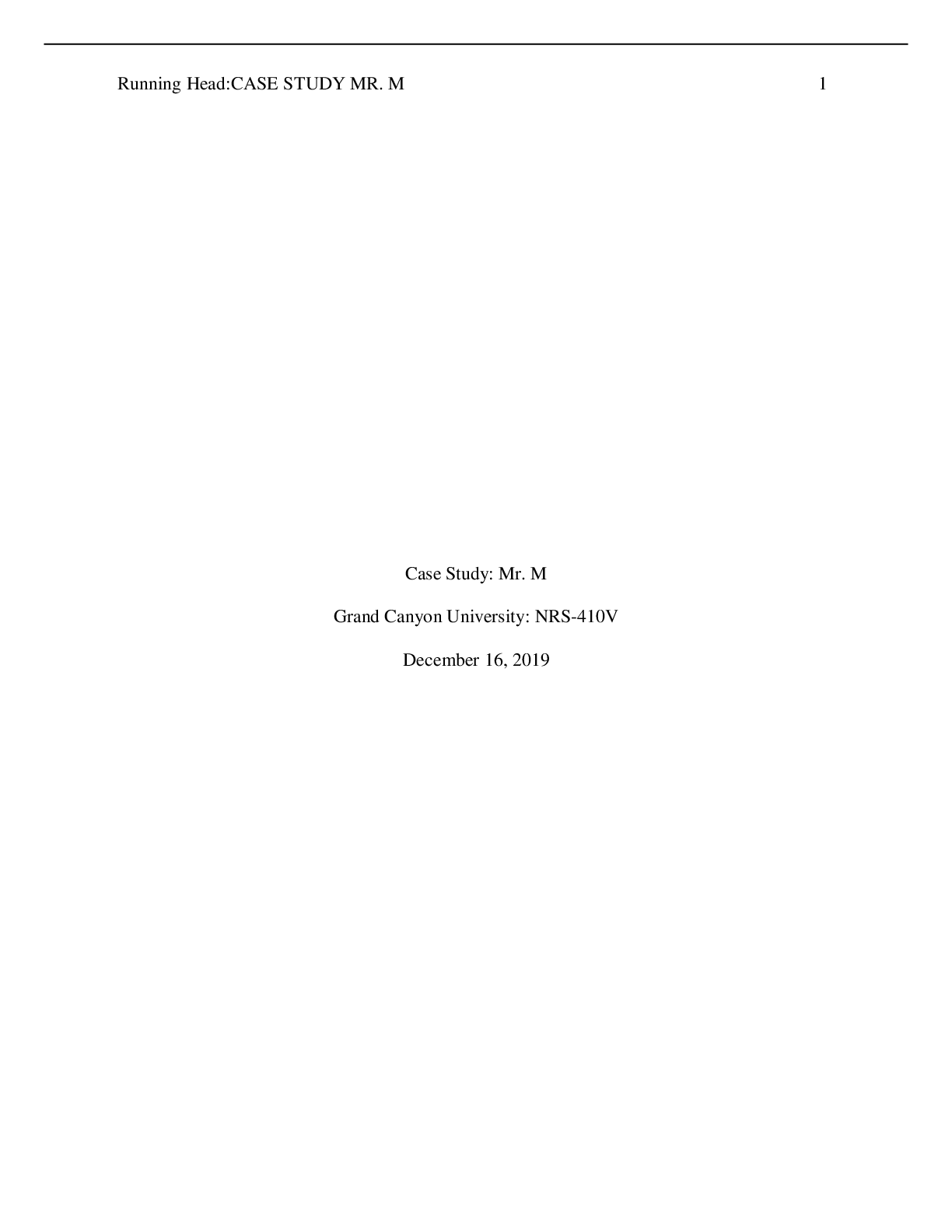
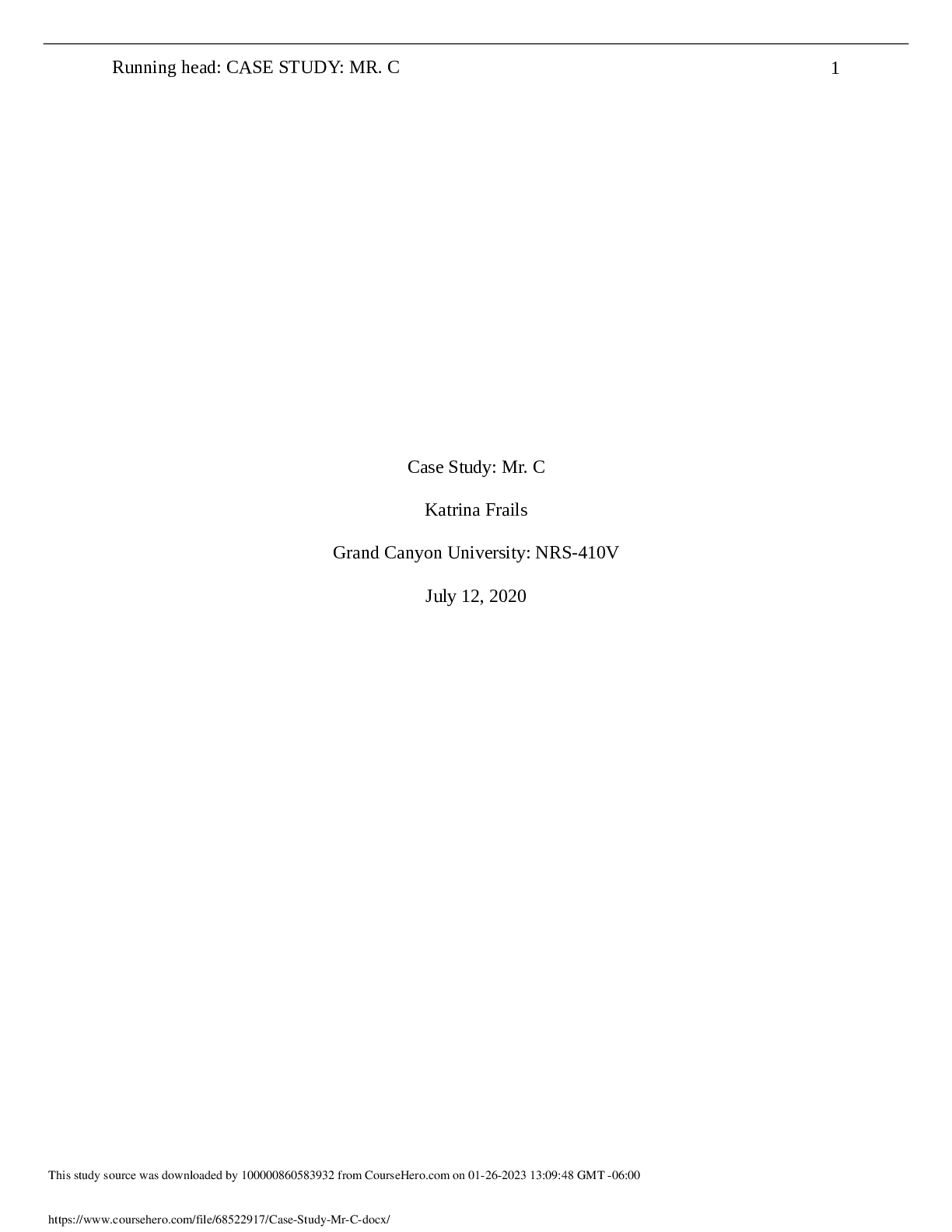
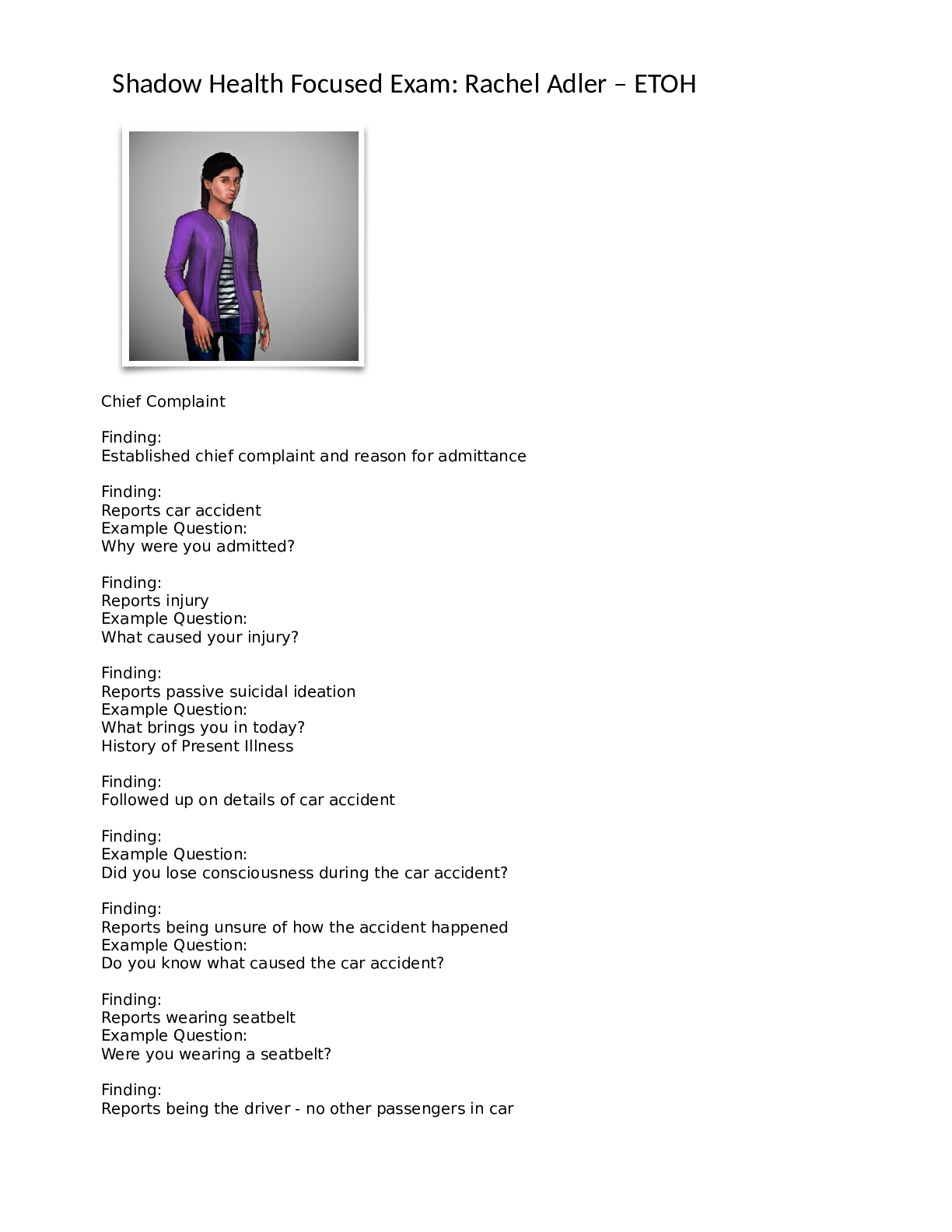

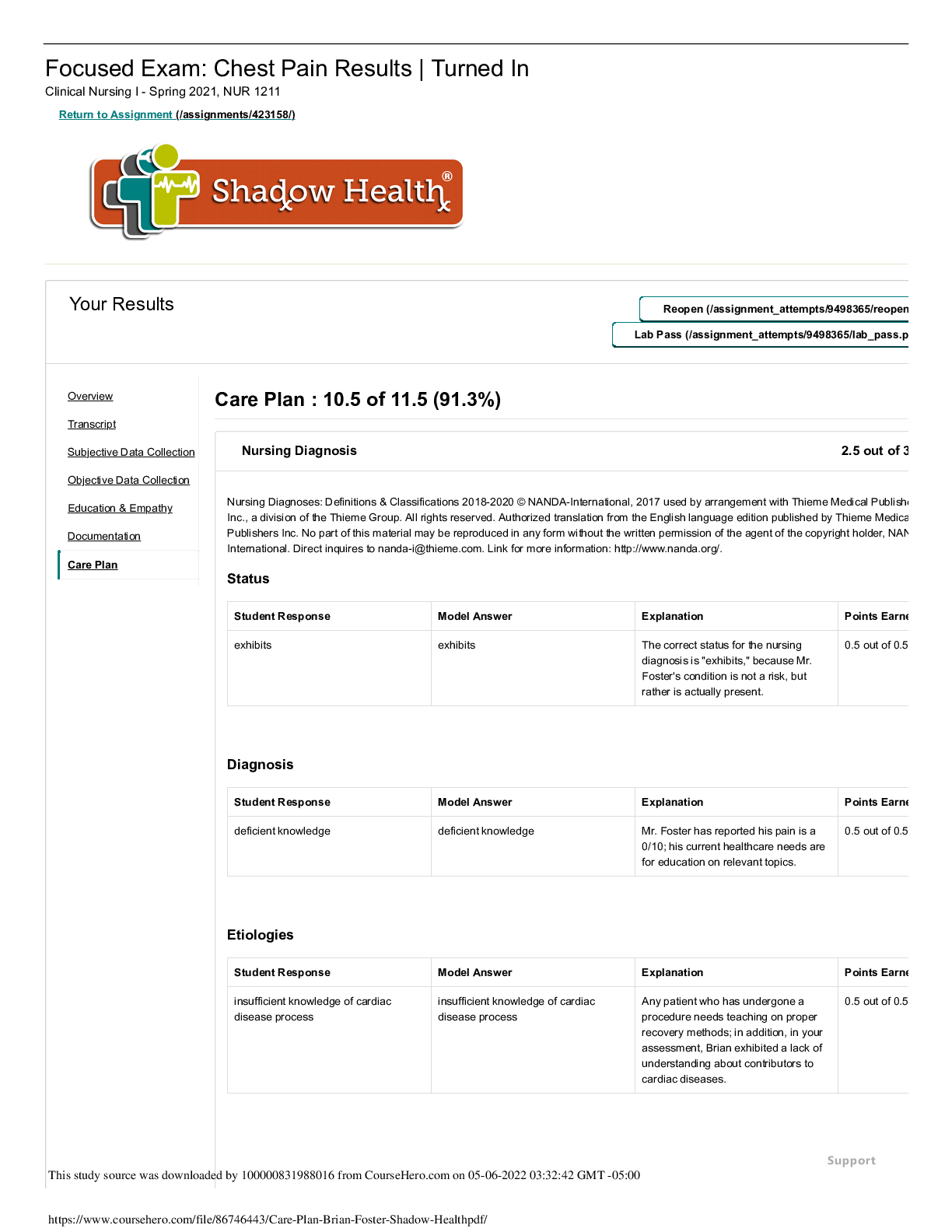
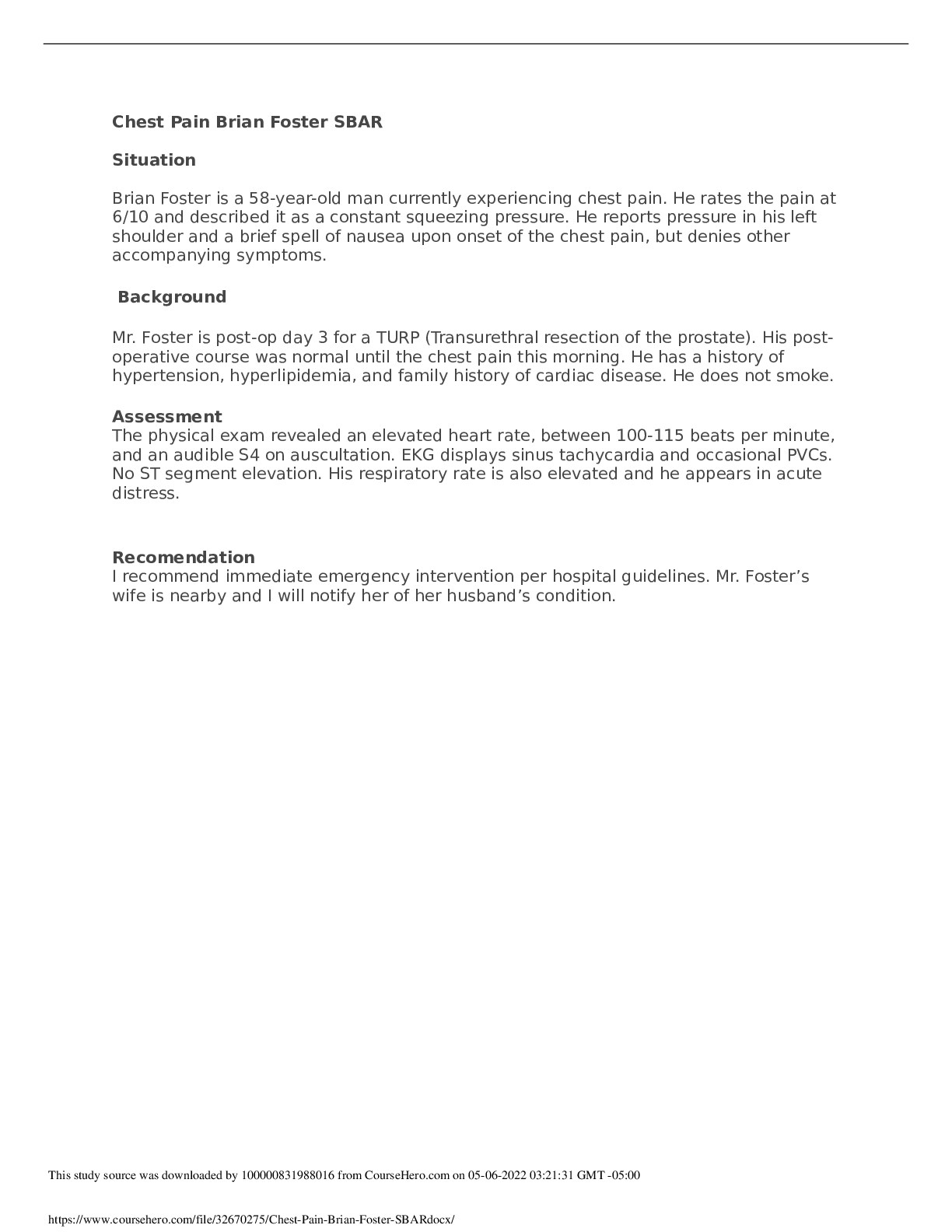
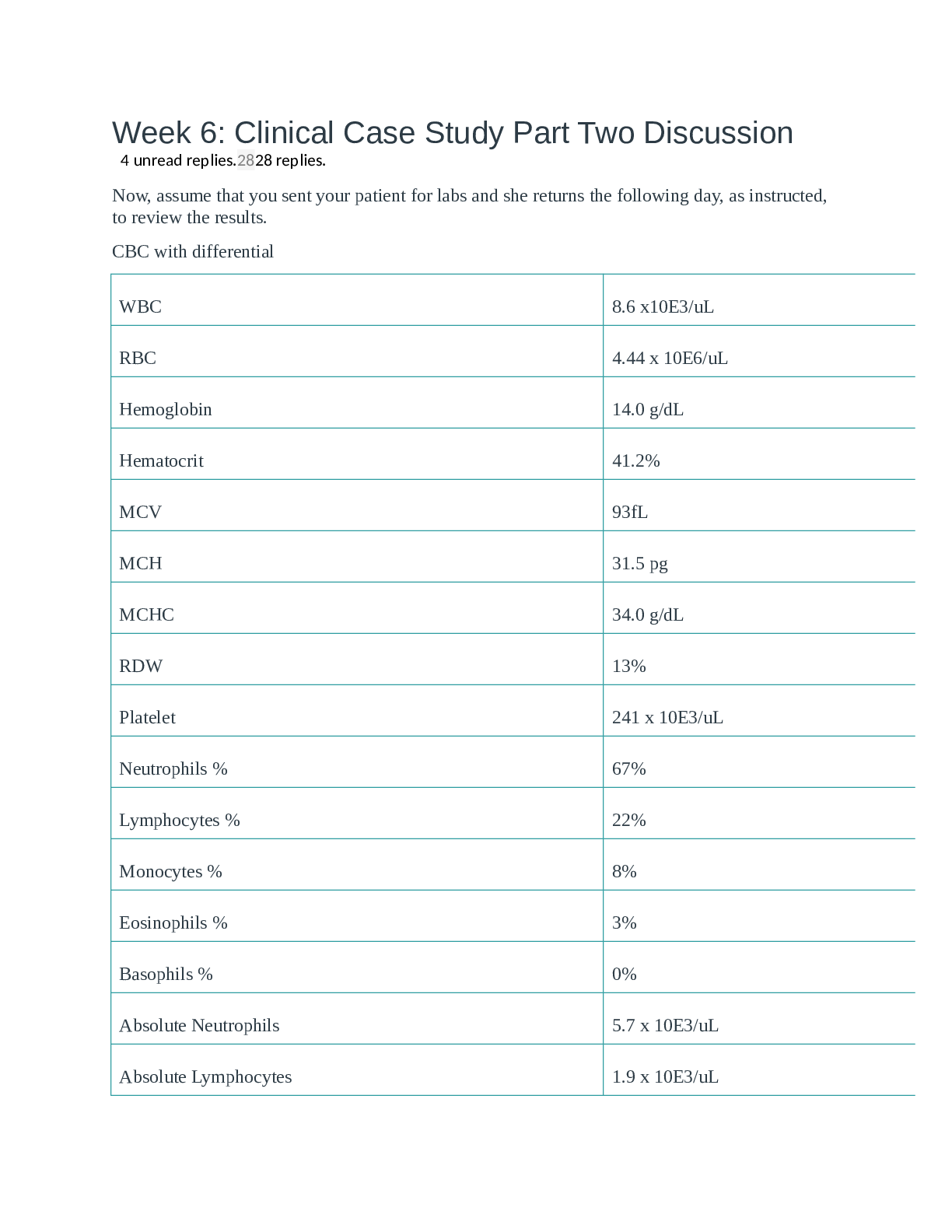
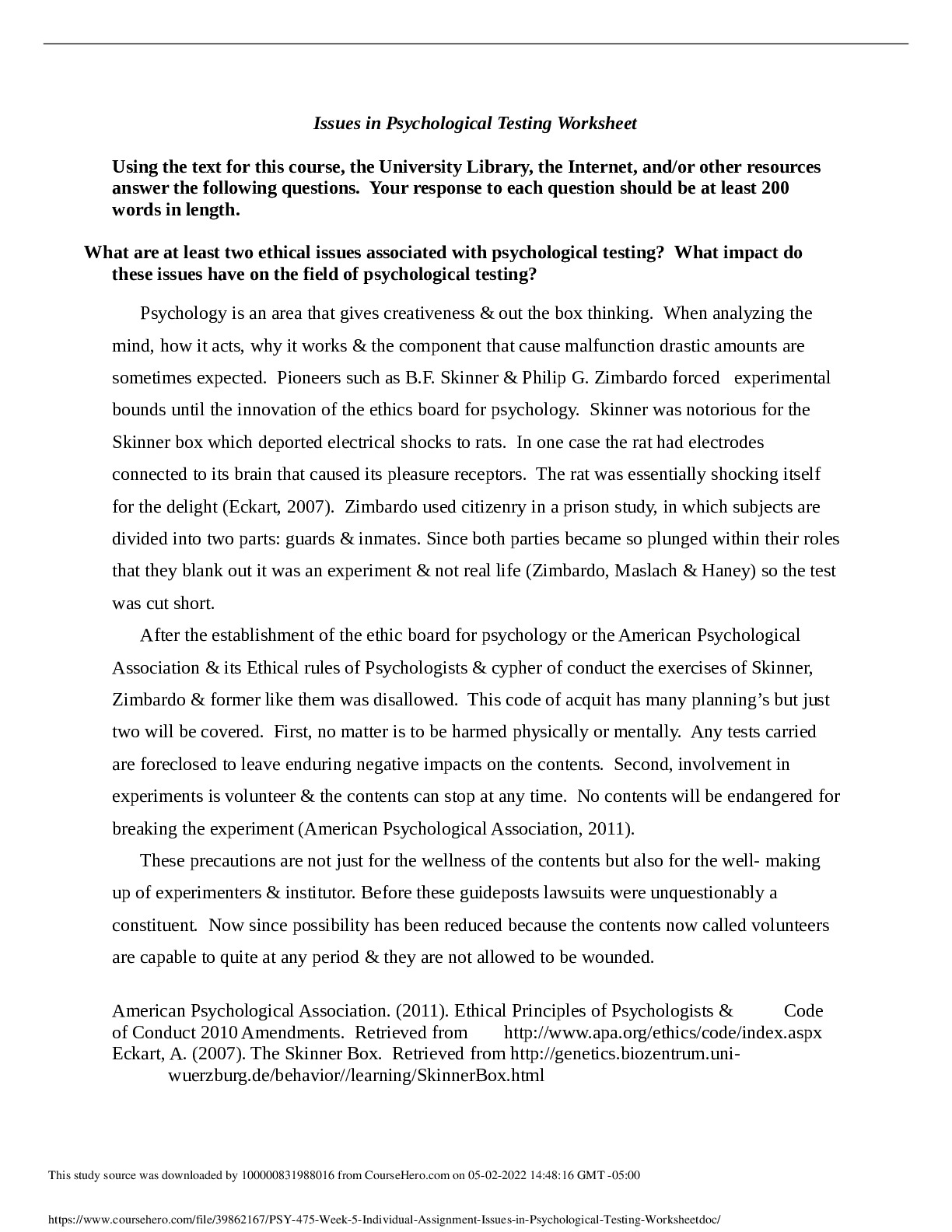
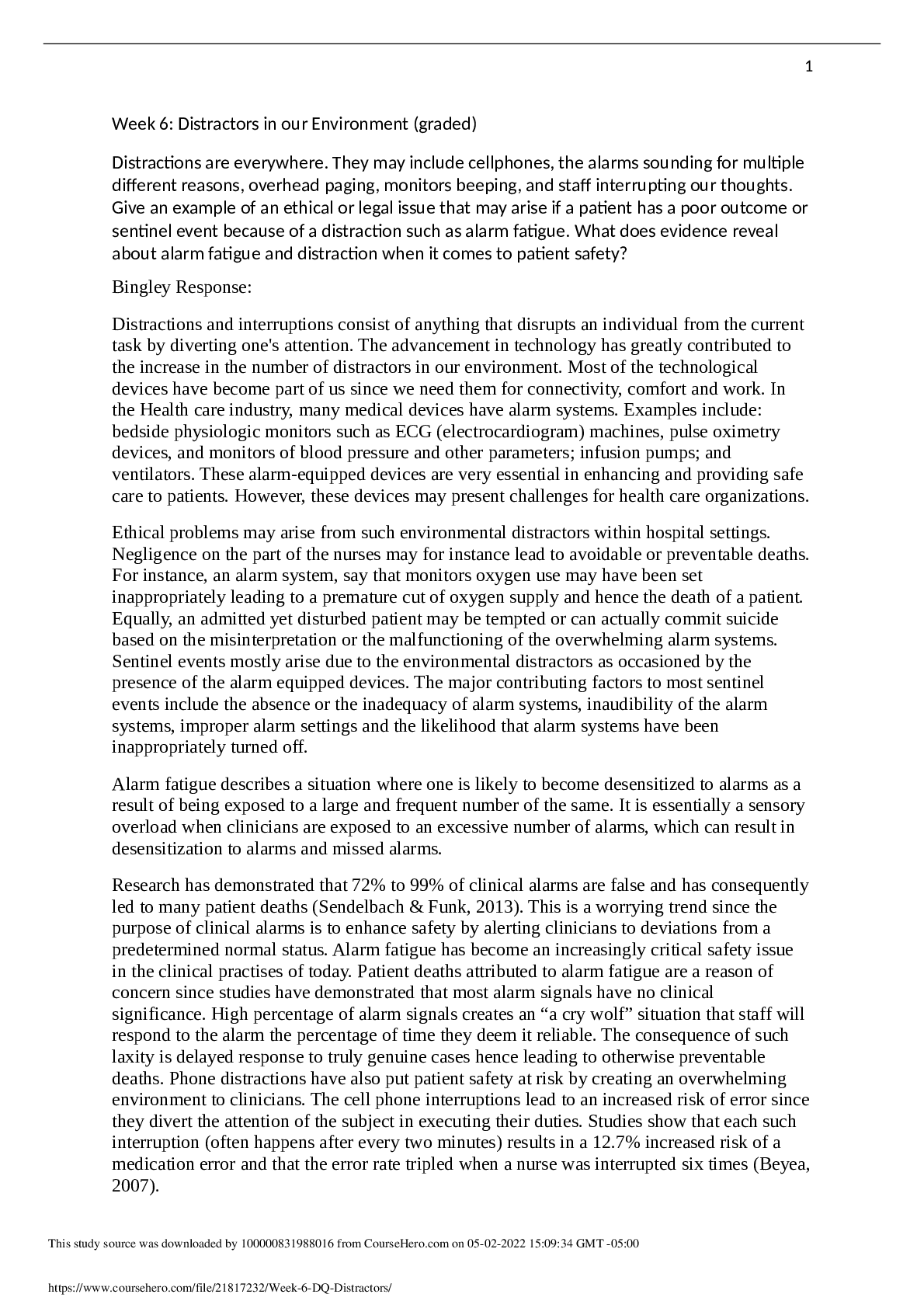
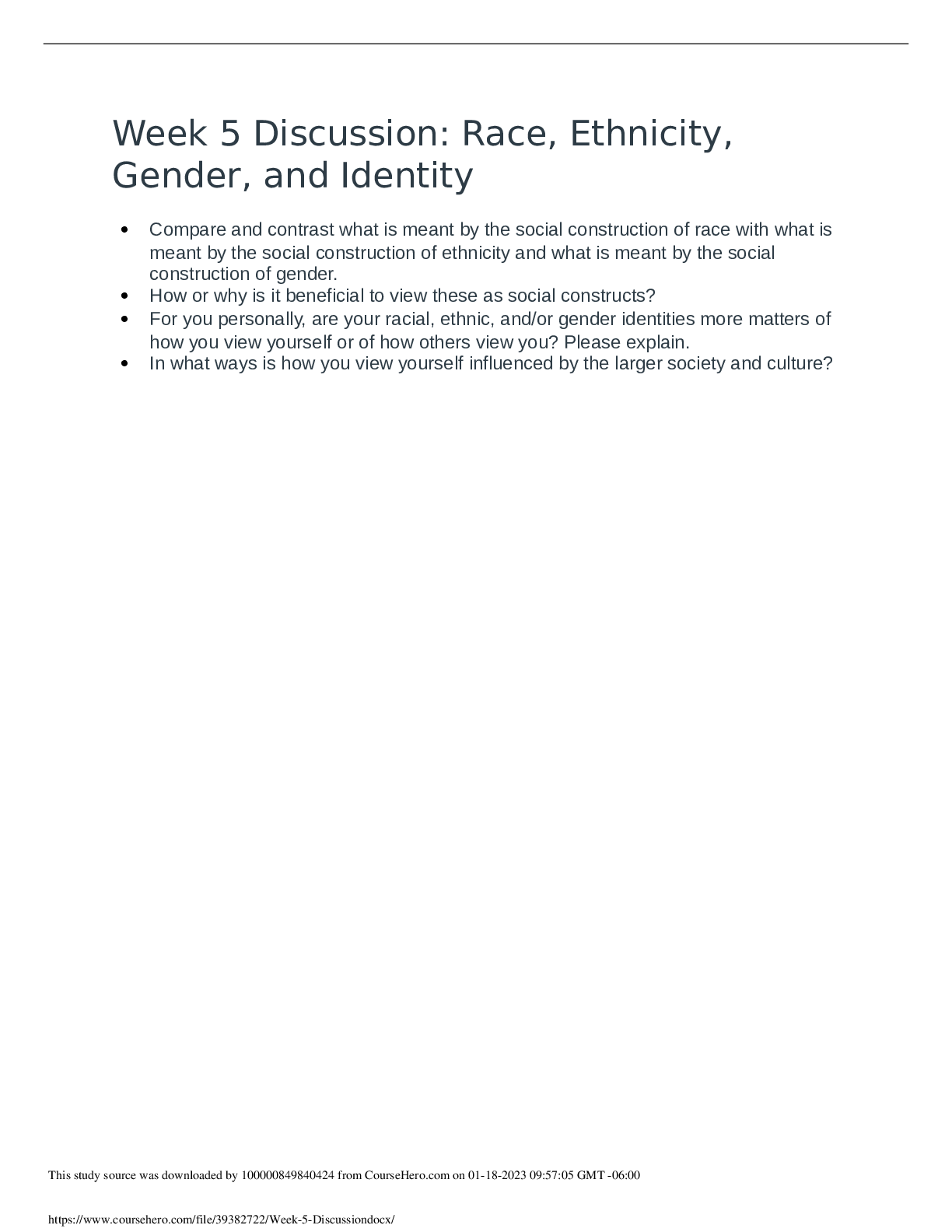
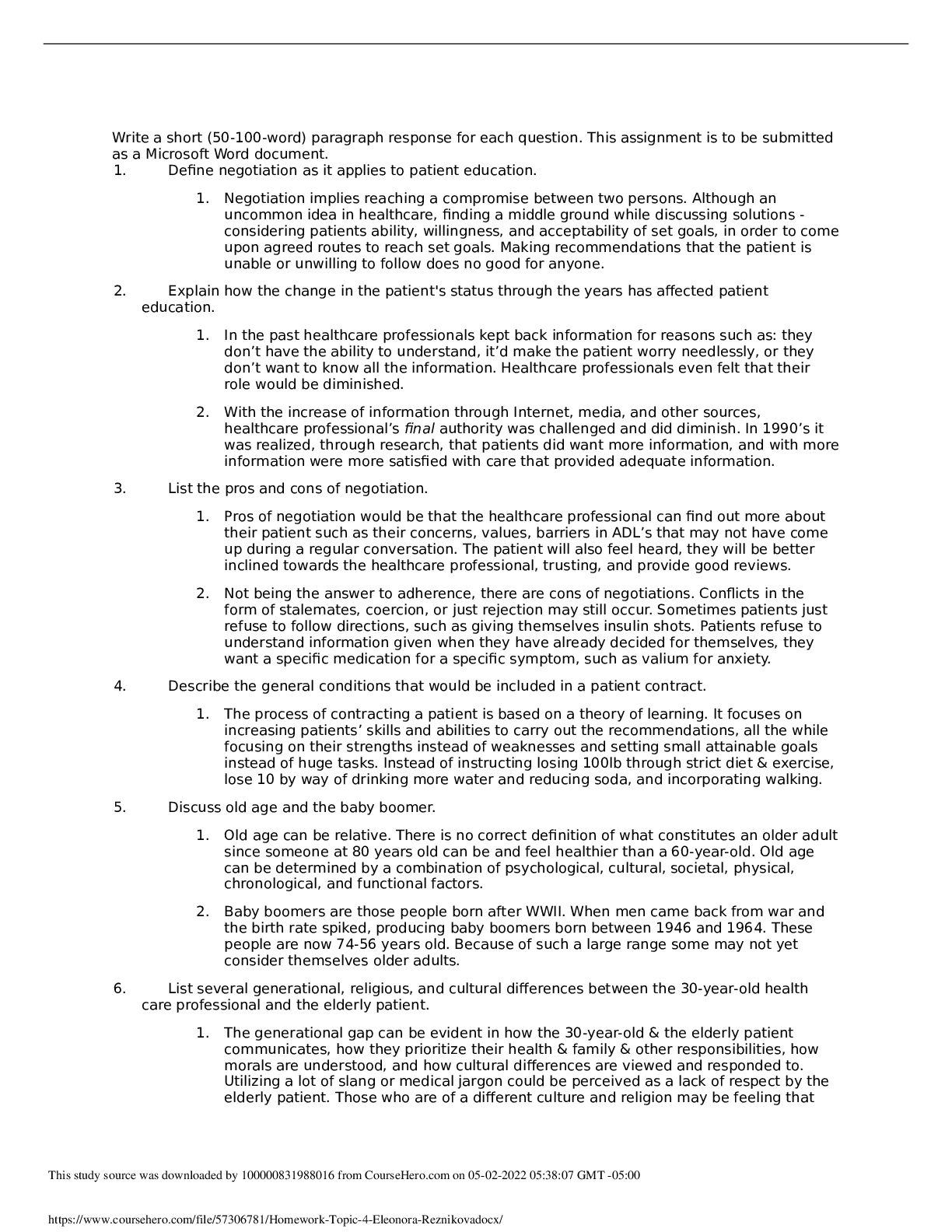
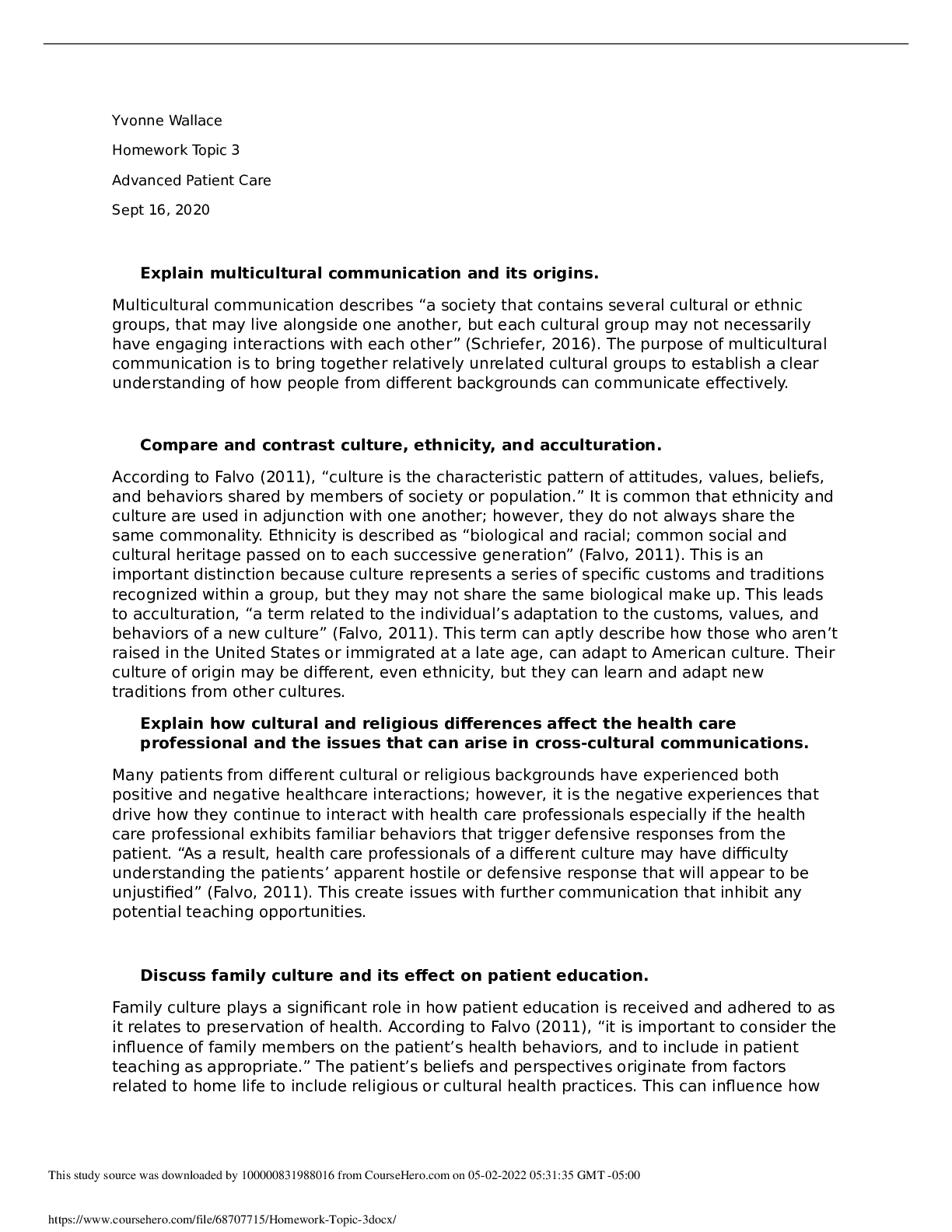
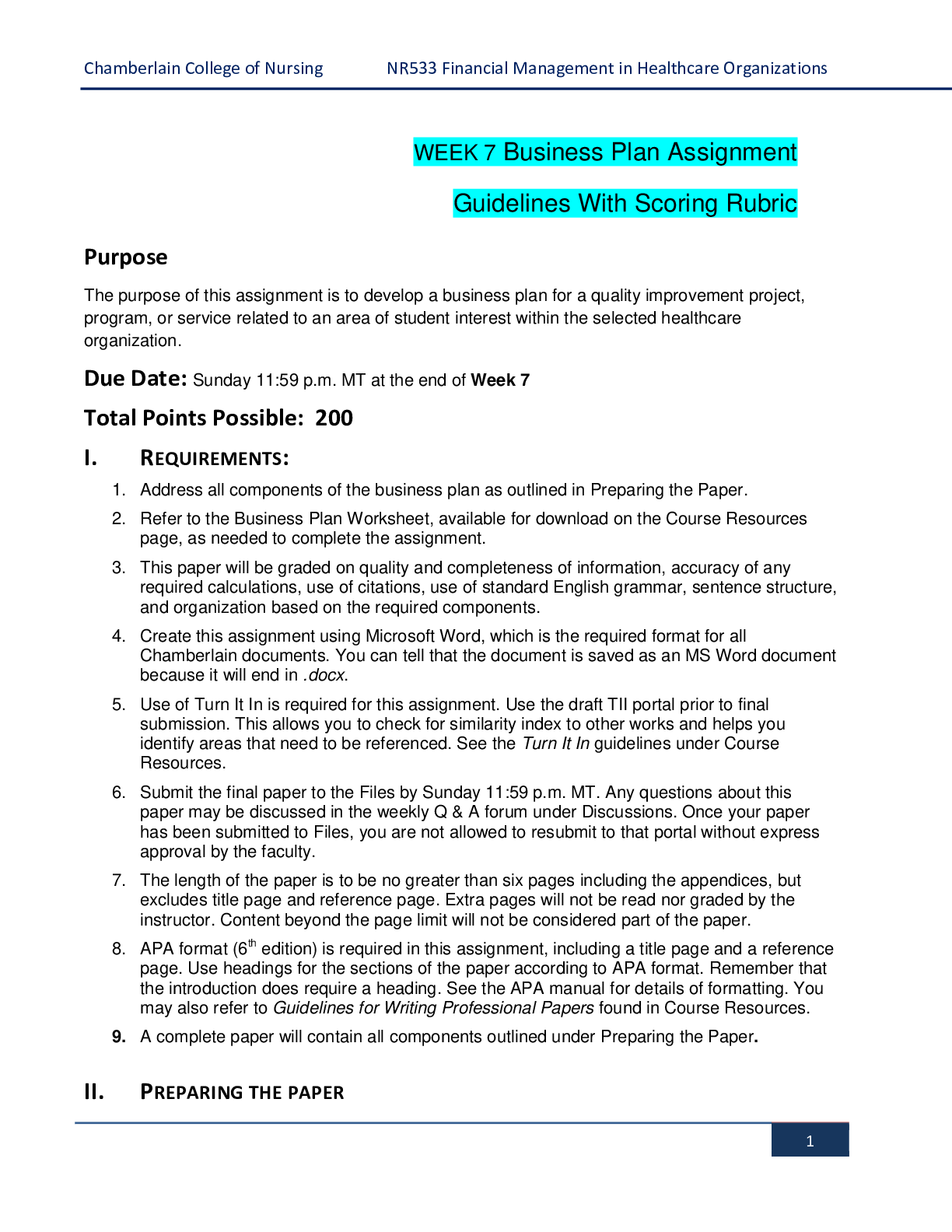
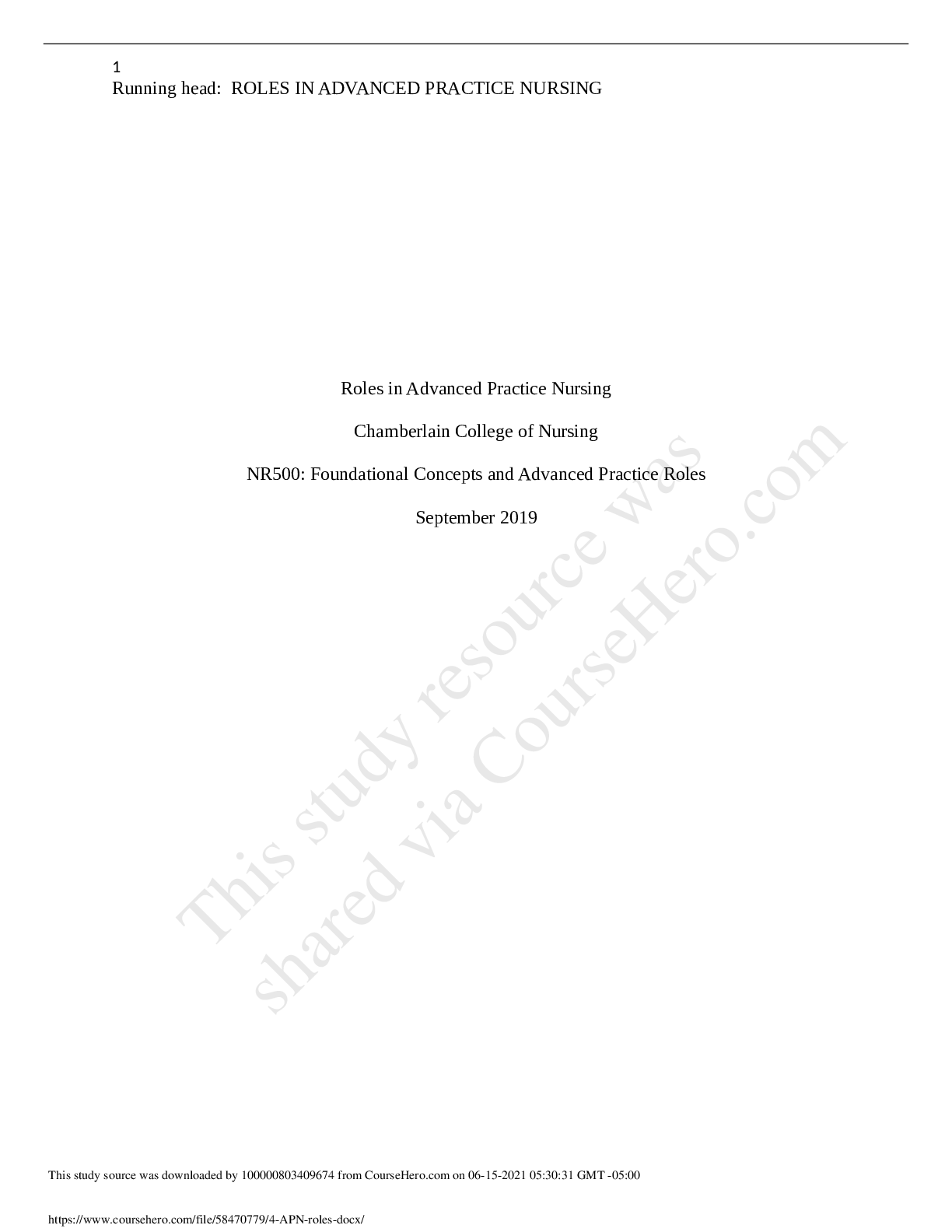
 Unfolding Reasoning.png)
